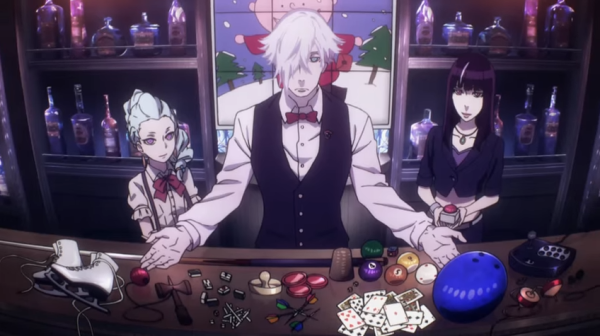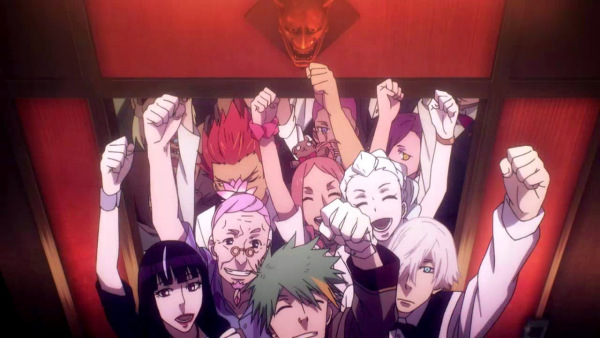Did you miss out on Part 1? Fear not! You can click here for the year in review and the bottom half of the Top 10, including honorable mentions. Or, if you’re ready to check out the cream of the crop, you can read on for more.
The Rankings
As a reminder, all seasons that ended in 2015 are eligible for this list, including sequels, even if they began their run in 2014 or earlier. Ongoing series (like Haikyu or Durarara) will be eligible in 2016.
So here we go, my five top (read: favorite) shows of the year! Drums rolled? Fingers crossed? Angry comments about the series I didn’t include typed and at the ready? Perfect. Let’s do this thing.
5. Noragami – Season 2 (Noragami Aragoto)

Streaming On: Funimation (U.S./Canada)
Season Episode Count: 13
Series Episode Count: 26
In a Sentence: A near-death accident renders ninth-grader Iki Hiyori capable of seeing and interacting with kami and spirits—including the down-on-his-luck “delivery god,” Yato.
Content Warning: Violence (adults/kids); emotional abuse (sympathetically handled); mild nudity
Noragami‘s first season surprised me by sneaking into my 2014 Top 10, and now its second season has surprised me by squeezing into my 2015 Top 5. Slickly animated, with an even balance of humor, tension, and drama, an ever-expanding (and coherent) Shinto/Buddhist mythology, and a mixed-gender cast of varying degrees of sympathetic and badass, Noragami is everything I look for in a shounen/action title and then some.
As expected out of BONES, the fight sequences are too-cool-for-school stylish and the art design striking (particularly on the eerie Phantoms), but what really makes Noragami shine is the way it develops its characters and (for the most part) has their actions organically affect the next chapter in the story, leading to small-scale emotional climaxes even more satisfying than the large-scale physical ones. The first arc was all but perfect, and while the second at times struggled with narrative cohesion, the way it turned its godly showdown into a personal tale of self-worth and second chances was as lovely a finale as any show this season. Keep this up, Noragami, and you just might replace FMA as my all-time favorite shounen series.
You can read both my episode posts and season review for more.
4. SHIROBAKO

Streaming on: Crunchyroll (USA, Canada, South Africa, Latin America, United Kingdom, Ireland, New Zealand, The Netherlands, Scandinavia, Turkey, and Australia)
Episode Count: 24
In a Sentence: This workplace sitcom follows Miyamori Aoi as she, her friends, and her coworkers at Musashino Animation navigate the often hectic, sometimes absurd, never-a-dull-moment world of the anime industry.
Content Warning: One episode deals (respectfully) with workplace sexism; occasional fat jokes (although the penultimate episode kinda makes up for it)
(Full disclosure: I’d settled on #5 and #1 for this list, but the three shows between them are lock-step with each other, all excellent but in very different ways. I was shuffling them around right up until I published the darn thing, and I’m still not sure how I feel about the order. But we’re out of time, so it’ll have to do.)
Between its career-minded female protagonists, unabashed love of anime, and understanding that even the dreamiest of jobs are still, after all, jobs (with all the redundancy and frustration that entails), perhaps it’s easy to see why SHIROBAKO speaks so strongly to me. It’s rare enough to find an anime about working adults, and rarer still to find one that actually focuses on the work and not on, say, romantic entanglements and office shenanigans.
SHIROBAKO provides a fascinating look into the anime industry, capturing the spirit if not always the letter, and does so with a lot of humor, an occasional bite of cynicism, and a tremendous amount of heart. While it’s first half can be rocky and at times even a bit trite, it develops is massive cast of realistically quirky coworkers over time, building to a second half that’s tense, funny, and fulfilling. I was cheering and tearing up for our young professionals and staff members by the end, and the sheer, exuberant joy SHIROBAKO provided during its strongest moments was one of the highlights of the year. Long live anime, and long live the people who work so hard to bring it to us.
You can read my series review for more.
3. Maria the Virgin Witch (Junketsu no Maria)

Streaming On: Funimation (US/Canada)
Episode Count: 12
In a Sentence: In this fantasy reimagining of the Hundred Years’ War, the witch Maria seeks to stop the endless fighting, despite her status as an outcast and heretic.
Content Warning: Violence (adults/teens); nudity/sexuality; deals (very tastefully and respectfully) with rape and sexual assault
“Nuance” is my favorite compliment to give a piece of fiction. It suggests thoughtfulness, a balanced look at competing factions and ideals, and a thorough understanding of both individual and cultural motivations and concerns. A good critique needs nuance, to acknowledge that the world is more than blacks and whites, in order to carry real weight.
Maria the Virgin Witch is a historical fantasy masquerading (briefly) as a bawdy comedy that is in fact a character-driven, smartly nuanced look at theology, religious establishments, violence/war, and especially female agency and institutionalized oppression. It acknowledges both admirable traits and glaring (or outright despicable) flaws in all of its characters and organizations, which only makes its triumphant conclusion—equal parts compromise, understanding, and cheerful, individualistic rebellion—ring all the louder.
I liked this one a lot the first time through, but it’s even better upon second viewing, and Maria herself is quickly climbing the ranks of my favorite female characters. Awkward titles (and some discomfiting early-episode humor aside), this is an impressively woven and intelligent feminist series, well worth the watch and a place in the Top Three.
2. Death Parade

Streaming On: Funimation (US/Canada)
Episode Count: 12
In a Sentence: Two people arrive at a strange bar with no memory of how they got there, only to be told by the bartender that they must play a game in order to leave—and that they must play with their lives on the line.
Content Warning: Violence (adults/teens); deals with a lot of difficult topics such as suicide, sexual violence, infidelity, and the afterlife (I think it’s all handled fairly well, but it’s still there)
Death Parade is a difficult show—at times difficult to watch, and at times difficult to know what it’s trying to say. That isn’t meant as a critique, though. “Difficult” can be good, especially when it’s intentional, and here I think it very much is. Death Parade is interested in exploring human life and all the ugliness and beauty that entails. As our protagonists challenge what it means to judge somebody and resist an easy cut-and-dried answer, so too does the series itself resist any simple conclusions to even its most straightforward episodes or one-off characters.
Who’s right? Who’s wrong? Who deserves forgiveness and who doesn’t? And who gets to decide that? Death Parade is interested in the questions, but less so in personally answering them. Instead, it wants to present and then provoke. It is an intensely provocative series, in fact, prodding at topics that are sure to hit a nerve with the audience (abuse, suicide, infidelity) and then asking them to consider and debate with one another. It makes the audience complicit in the judgment, and pushes them to understand the many, many layers present not just in its characters, but in actual people as well.
As a fairly episodic character study, some games resonate more strongly than others, and some rely too heavily on melodrama to hit as hard as they’d like. But as an overarching story about Decim and Onna, it’s an equal-turns painful and inspiring tale of friendship and empathy, and how we give our lives meaning through the way we affect others. Death Parade may not provide any grand cosmic answers, but it provides many small, personal ones. Maybe that’s the best kind of answer we can hope for.
1. Yurikuma Arashi

Streaming On: Funimation (US/Canada), Crunchyroll (here’s a link to the list of regions)
Episode Count: 12
In a Sentence: The long-running battle between humans and bears takes a surprising turn when two bears disguise themselves as humans and infiltrate Kureha’s high school, disrupting both her and her girlfriend’s lives—and wow, this show is impossible to describe in a sentence.
Content Warning: Violence (teens/adults); sexuality/nudity (female); assault; graphic depictions of bullying
I wrote a small book on this series as it was airing, analyzing and theorizing and head-scratching as I went. As emotionally moving and thematically brilliant as I found its finale, I felt like I was a little too close to it and its auteur director (Kunihiko Ikuhara of Sailor Moon and Utena fame) to give it the top spot during that wonderful Winter season. So I slid it in at #3 and waited to see how it would age. And, well, here we are.
Staggeringly ambitious, viscerally affecting, and stuffed to the gills with imagery and visual motifs, Yurikuma uses its surreal world and adorably creepy bears to discuss and critique the harmful tropes present in yuri (lesbian) fiction, how women and especially lesbians are treated in Japanese society, the dangers of zealotry and mob mentality, and (of course, this being Ikuhara) institutionalized oppression, “othering,” and how to combat a broken system.
And yet for all its Big Ideas and allusions, it is still, at heart, a very personal and sweet (and at times darn funny) little love story about individuals overcoming prejudice and selfishness and coming to understand and accept one another for who they are. I began this one all pipe-and-monocle scholarly about it and ended up becoming deeply invested in its characters and story, cheering their growth and urging them to a happy ending.
Yes, it indulges a bit too much in darkness and eroticism in the early going (intentionally, I think, to build audience prejudices so that it can later challenge them, though there’s an argument to be made it was done to excess), but it develops its characters and themes with such obvious affection and passion that it’s easy for me to forgive any early missteps. Taken as a complete work, Yurikuma is a messy, chaotic, thoughtful, earnest, intimate, moving, and aggressively progressive piece of fiction, a flawed masterpiece but a masterpiece nonetheless. For both the thoughts it provoked and the tears (and giggles) it evoked, it’s earned the year’s top spot.
In addition to those episode recaps, you can read my series review (or scroll to the end for some spoiler-filled analysis) for even more.
And that’s all she wrote! Thanks as always for your kind likes and shares and comments, and I hope to keep speaking to and with you all again in the coming year as well. Onwards to 2016!
Dee is a nerd of all trades and a master of one. She has bachelor’s degrees in English and East Asian studies and an MFA in Creative Writing. To pay the bills, she works as a technical writer. To not pay the bills, she devours novels and comics, watches far too much anime, and cheers very loudly for the Kansas Jayhawks. You can hang out with her at The Josei Next Door, a friendly neighborhood anime blog for long-time fans and newbies alike, as well as on Tumblr and Twitter.
—Please make note of The Mary Sue’s general comment policy.—
Do you follow The Mary Sue on Twitter, Facebook, Tumblr, Pinterest, & Google +?









Published: Jan 5, 2016 01:48 pm